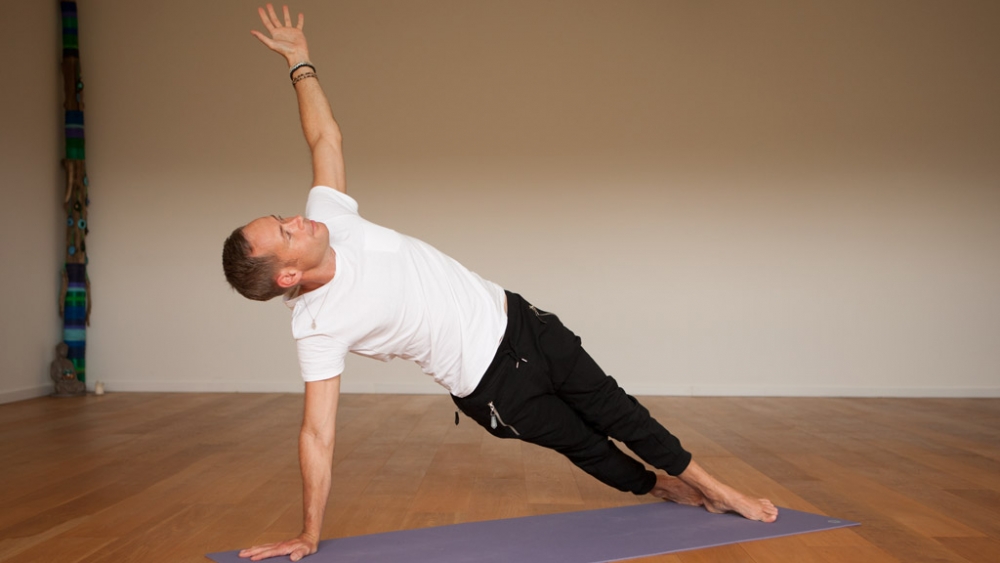Kosha, a Sanskrit word meaning ‘sheath’ or ‘covering’, describes those elements of being which must be explored, welcomed, balanced and ultimately transcended in order to experience your true self. Explore the Koshas on and off the mat with James…
The Koshas – Gateways to the soul
In this five-part series, James starts each class with a short talk followed by a practice. Each practice is focused on sensing and uncovering each of the five koshas from which to explore and journey to our innermost being. The journey could land you in the fifth Kosha – or ‘soul body’ – of joy, bliss and equanimity, and the stillness which animates it all.
1. The physical body (Annamaya Kosha)
The body, in its essence, is merely sensation, so we must learn to dive into this sensation and become open to more and more subtlety and ‘vibratory aliveness’ in our practice. This requires a yoga practice which is meditative in its nature, and slow and considered enough to allow us to notice sensation in ever deepening ways.
About the class
Balance and relax the body – In the first class of the series, James explores this theoretically and experientially, through movement and breath and a long rest at the end of class. The end result? A steady and comfortable body, leading to a steady and comfortable mind.
2. The energy body (Pranayama Kosha)
The kind of practice that balances our energy Prana (life force) is the familiar ‘Hatha’ yoga, though with a focus on Bandhas (energetic locks and seals) and breathing into poses to really open your energy body. This practice is energising and revitalising.
About the class
Harmonise the energy body – In the second class, James starts with a presentation on the energy system and the Prana Vayus. Then by working with particular poses and sensing into sensation in the different locations of these subsets of energy, connect with these forces within your own body.
3. Feelings and emotions (Manomaya Kosha)
At this ‘layer’ we experience ‘energy-in-motion’ (‘e-motion’ for short). In our practice it is here that we begin to feel the hits of our feelings having opened ourselves energetically in the previous practice. This kind of ‘emotional yoga’ is experienced with long, yin-style holding of postures and diving in Feeling our body and energy body and paying attention to feeling. We’re literally ‘moved’, and as we are, profound shifts take place as we release and are freed from this kosha.
About the class
Working with the body to balance the emotions – In this class, James tends to each of the 7 chakras, resting attention on each one and observing what we feel in the body. The chakras are an ancient presentation of our human experience; we all feel our energy system every day as we experience various hits of emotion (‘energy in motion’), in the body (butterflies in your stomach, a tug at your heart, etc). Through movement, breath-work and contemplation our energy system becomes ever-more subtle and takes us further towards connecting us to the absolute.
4. Thoughts and beliefs (Vijnanamaya Kosha)
This kosha is met with meditation. Here we’re also likely to meet our old friend the ego, and face what it does and doesn’t like about your physical practice. Here you can look deeply at your preferences and understand how your ‘choosing and refusing’ of life (and yoga poses!) is taking you further away from your atman (true self), not closer to it.
About the class
Stable body, stable mind – in this class we will explore how a steady body leads to a steady mind. As we explore the postures, we will mindfully watch as our beliefs, thoughts and stories about what we do and don’t like, or what we are and are not good at, pour forth. Then, through steadiness, we will see our mind as a screen (‘chitta kasha’), on which we can invite the unconscious to release or reveal whatever it may want us to see or experience. The talk at the beginning of this video explains the Vedantic presentation of the mind and its four functions.
5. Joy (Anandamaya Kosha)
Joy is our birthright, as is equanimity. You know those times when you leave yoga class and feel like you’re OK with the world as it is? You feel no desire to fight, push away or control? We might also find ourselves happy or at ease for no particular reason at all. This is the Anandamaya Kosha, the body of bliss and equanimity.
About the class
Move yourself to freedom – In the fifth class we’re going to explore movement with one goal only: to become goal-less! The nature of your true self is spacious and open and free from desires and attachments. We’re going to slow down and wake up to awareness, and see for ourselves who we really are: nothing…and everything.
Follow the Koshas series with James Reeves
In this five part program for EkhartYoga members, James starts each class with a short talk followed by a Hatha yoga practice. Each practice is focused on sensing and uncovering each of the five Koshas from which to explore and journey to our innermost being. Follow the program here.

